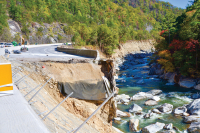WNC claims two of 2020’s three most visited National Park units
 Even during January this year, visitors crowd the space at Laurel Falls. NPS photo
Even during January this year, visitors crowd the space at Laurel Falls. NPS photo
Despite the pandemic — or perhaps because of it — Western North Carolina was home to two of the nation’s three most visited National Park Service units in 2020.
Last year, the Blue Ridge Parkway recorded 14.1 million visits, making it the nation’s most-visited unit, while the Great Smoky Mountains National Park received 12.1 million visits, making it the third most-visited unit and far-and-away the most visited National Park, claiming quadruple the number of visits of second-place Yellowstone National Park, with 3.8 million.
“I’m proud of our staff and partners who worked diligently to develop COVID-safe protocols that enabled us to safely provide access to the park during a time when people were desperate to spend time in this special place for healing and refuge,” said Smokies Superintendent Cassius Cash. “But, this increase in use didn’t come without a cost. Visitors experienced even more congestion, the busiest places in the park became even busier, and visitors often left behind litter and damaged roadsides from out-of-bounds parking.”
While both the Parkway and the Smokies recorded lower visitation numbers in 2020 than in 2019, the parks were actually much busier during the height of the season. Both parks enacted significant and lengthy closures at the beginning of the pandemic, but once they reopened, people came in record numbers.
Between June and December, when most Smokies roads were open, the park had one million more visits than during the same time period in 2019 and 2.3 million more visits than the ten-year average for that time period. The park set individual monthly visitation records for each month August through December, with November visitation coming in 28.2 percent higher than November 2019. Roads, trails, frontcountry campgrounds and backcountry campsites were all busier than normal. Once frontcountry campgrounds opened in September, use increased more than 33 percent for the remainder of the year over the same time period in 2019. In the backcountry, June through December camping increased 47 percent over the same time period in 2019.
The Oconaluftee entrance in Cherokee saw a smaller share of this increase, with overall visitation through that entrance falling 11 percent compared to 2019, while the Gatlinburg entrance had 6.5 percent fewer visits than the previous year. Outlying areas of the Smokies actually saw a 0.9 percent increase over 2019, despite the spring closure, and the Townsend entrance, which serves Cades Cove, marked a 2.1 percent increase.
Related Items
The surge follows a 20-year trend of increasing visitation in the Smokies. Over the last year, park managers have been working with local communities and visitors to discuss the challenges posed by this heightened level of use and to discuss possible solutions for the years ahead.
While many sections of the 469-mile Blue Ridge Parkway saw a marked decrease in annual visitation compared to 2019 — including a park-wide decrease of 6 percent for the year as a whole— the Parkway’s southern end in WNC saw a huge jump, despite nearly two months of complete closure. The U.S. 441 entrance recorded 192,209 visits last year, a 37.1 percent jump from 2019. The U.S. 23/74 entrance at Balsam Gap saw a 35.7 percent increase, the U.S. 19 entrance at Soco gap saw a 33.6 percent increase and the N.C. 215 entrance saw a 26.5 percent increase. The entrance at U.S. 276 saw a smaller but still significant 14.2 percent increase.
“The 2020 visitation reminds us that the Parkway’s 1930s design approach, to maximize scenic views and recreational access, continues to be relevant today for those looking for respite and renewal,” said Blue Ridge Parkway Acting Superintendent Alexa Viets.
For in-depth park statistics, visit irma.nps.gov/STATS.









